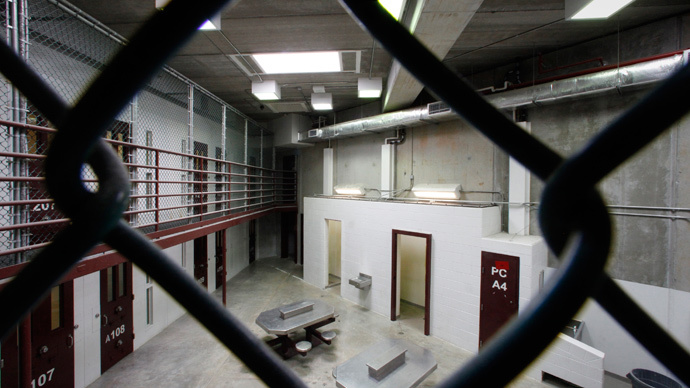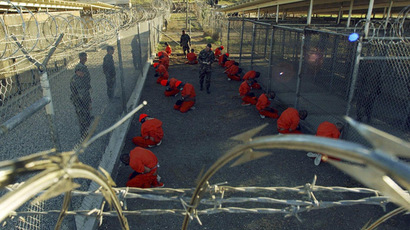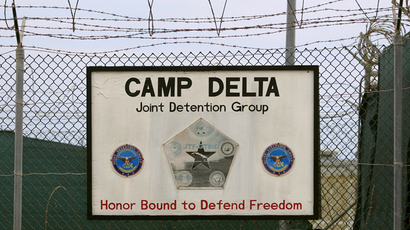Gitmo force-feeding videos must be released by end of August - judge

The US government has until August 31 to prepare and release eight of 32 videos depicting the "disturbing" force-feeding of a detainee held for 12 years at the Guantanamo Bay military detention complex, a federal judge ordered.
US District Judge Gladys Kessler excoriated lawyers for the US Department of Justice (DOJ) on Thursday for the government's delay in releasing the footage after she first ordered negotiations for their preparation in October. The DOJ lawyers said it was feasible to have only eight tapes of the 32 at issue edited properly (to avoid identifying soldiers taking part in the forced feedings) and delivered to former detainee Abu Wa’el Dhiab’s counsel by August 31.
Though frustrated by the government's slow pace, Kessler agreed with the DOJ's proposed timeline, warning she would offer "no extensions of time."
Kessler also took issue with the government's appeal of her order in October before the redaction negotiations were completed. That appeal was denied in May by an appellate court.
"The government has made it possible to delay this for, according to my count, eight and a half months," Kessler said in court. "Eight and a half months! The government’s appeal was as frivolous an appeal as I have ever seen. Of course, the Court of Appeals didn’t have jurisdiction. The minute I heard you were going to go up [to the Court of Appeals] I remember then talking to my law clerk saying ‘I don’t understand this, the case is still on my docket. The Court of Appeals doesn’t have jurisdiction now. But that’s neither here nor there'.”
The government has until September 30 to edit two separate video compilations of force-feeding.
READ MORE: US wants Guantanamo force-feeding hearing to stay secret
The case involves Syrian native Abu Wa’el Dhiab, 43, who was held at Guantanamo Bay from 2002 until his release to Uruguay in December 2014. Dhiab was cleared for release in 2009, but continued to be held at the camp. He protested with other detainees and initiated a hunger strike in early 2013, prompting the use of force feeding. At the hunger strike’s zenith in 2013, up to 100 inmates were refusing to eat in protest at their indefinite detention.
The video footage in question purportedly shows Dhiab being removed from his cell against his will and fed via a tube that went through his nose and into his stomach. Dhiab estimates he was force fed 1,300 times during his incarceration at Guantanamo.
“The government has been rightly chided by the judge and now will be made to give real reasons for every frame of this footage that they want to keep hidden from the public,”said Cori Crider, an attorney with the UK-based organization Reprieve, which is representing Dhiab in the case. “Images of a suffering detainee are matters of public importance and should no more be suppressed than those of Abu Ghraib, Eric Garner or Rodney King. An administration truly committed to transparency would release the tapes forthwith.”
The case was originally filed by Dhiab to stop the practice and the footage was introduced as evidence under seal during the trail. Lawyers for Dhiab, who have seen the videos, have called them “disturbing.”
Dhiab had asked the court to prohibit the military from both removing him from his cell and engaging in forced feeding, a process he likened to torture. The government adamantly denied the comparison, arguing that forced feeding was necessary to prevent the inmates from dying of hunger.
READ MORE: Guantanamo Bay prison hunger strike
The government argued that releasing the videos – which had been declared classified – could potentially allow inmates to form “countermeasures” against “forced cell extractions.”In October 2014, Kessler rejected the government’s arguments that the tapes are classified and that releasing the videos would harm national security and “inflame Muslim sensitivities overseas.” She declared the arguments were “unacceptably vague, speculative,” or “just plain implausible,” according to the Intercept.
“Given what is already available to the public and known to the detainees, it simply is not plausible to argue that release of the videos will give rise to an additional probability of harm by encouraging the development of FCE [forced cell extractions] countermeasures,” Kessler said last year.
She ordered the videos to be made public, with redactions to protect the identity of Guantanamo guards. The government appealed that decision.
A federal appeals court ruled in May that it was "without jurisdiction" to issue a dismissal of the release orders, handing the government another defeat in its quest to shield the videotapes.
Sixteen media organizations including the Intercept, McClatchy, the New York Times and the Washington Post have intervened in the case to press for the release of all 32 tapes, which span about 11 hours.
“This whole thing is a ploy,” David Schulz, attorney for the press organizations, said of the government's proposal at the court hearing on Thursday, according to the Intercept's recap of Thursday's proceedings. “It’s delay, delay, delay.”
READ MORE: Guantanamo Bay: An untold history of torture and resistance
Dhiab's attorneys noted on Thursday that the government's timetable for release has been extremely dilatory. The government responded saying that video editors at the Pentagon have found the redaction process "to be much more burdensome and time-consuming" than originally thought.
“This is a very difficult project that is to some degree unprecedented,” DOJ lawyer Andrew Warden said in court, adding that “there are real practical and technological burdens with the redaction process.” The editors are tasked with reviewing and redacting identifiable information from every frame of the videos. Each second of the videos contain 30 frames, they said.
The defense pushed for more urgency.
“Video editors do that all the time,” said Dhiab's
attorney, Eric Lewis. “It’s a matter of commitment and
resources.”
The government will have the opportunity to appeal once again before the videos are finally released to the public.
“The government must be told loud and clear that delay tactics will not work and that the world will see the abuse that has continued at Guantanamo," said Alka Pradhan, a member of Dhiab's defense.














